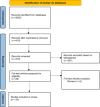Robotic-assisted hip and knee revision arthroplasty: A scoping review
- PMID: 40421409
- PMCID: PMC12104824
- DOI: 10.1002/jeo2.70285
Robotic-assisted hip and knee revision arthroplasty: A scoping review
Abstract
Purpose: Technological advances have significantly revolutionised orthopaedic surgery over the past decades. The introduction of robotic-assisted (RA) systems in total joint arthroplasty (TJA) surgery, especially in total hip arthroplasty (THA) and total knee arthroplasty (TKA), represents a key innovation. While the advantages of robotic assistance in primary joint replacement surgery are relatively well known, its application in hip and knee revision surgery implies a more complex and challenging scenario. The procedures needed are inherently more difficult compared to primary arthroplasties because of considerable bone loss, scar tissue, compromised anatomical landmarks, and at times even damaged or eroded joint structures.
Methods: This scoping review synthesises existing literature on the application of RA systems in revision hip and knee arthroplasty. A systematic search on the six major databases in September 2024 identified 24 eligible studies for inclusion.
Results: Although various studies and case reports have demonstrated the successful use of robotics in TJA surgeries, the existing body of literature concerning revision surgery is still limited, and many questions remain unanswered. While, for instance, robotic systems seem to have held some promise for better improvement in implant positioning and alignment, it is still quite unclear whether this development in technological advancement will translate into better long-term outcomes such as improved implant longevity and lower revision rates.
Conclusions: Although early data are promising, having some possible short-term advantages, wide diffusion is limited because of high costs, significant training requirements, and limited long-term outcome data. By identifying gaps in the current literature and emphasising areas for future investigation, this review aims to define the ongoing development and refinement of RA applications in revision arthroplasty, ultimately seeking to determine whether these technologies can achieve sustainable improvements in implant longevity and patient satisfaction.
Level of evidence: Level III.
Keywords: hip; joint replacement; knee; revision arthroplasty; robotic‐assisted arthroplasty.
© 2025 The Author(s). Journal of Experimental Orthopaedics published by John Wiley & Sons Ltd on behalf of European Society of Sports Traumatology, Knee Surgery and Arthroscopy.
Conflict of interest statement
The authors declare no conflicts of interest.
Figures
Similar articles
-
Robotic-assisted revision total joint arthroplasty: a state-of-the-art scoping review.EFORT Open Rev. 2023 Jan 27;8(1):18-25. doi: 10.1530/EOR-22-0105. EFORT Open Rev. 2023. PMID: 36705615 Free PMC article.
-
Technological innovations in shoulder replacement: current concepts and the future of robotics in total shoulder arthroplasty.J Shoulder Elbow Surg. 2023 Oct;32(10):2161-2171. doi: 10.1016/j.jse.2023.04.022. Epub 2023 May 30. J Shoulder Elbow Surg. 2023. PMID: 37263482 Review.
-
Robots in the Operating Room During Hip and Knee Arthroplasty.Curr Rev Musculoskelet Med. 2020 Jun;13(3):309-317. doi: 10.1007/s12178-020-09625-z. Curr Rev Musculoskelet Med. 2020. PMID: 32367430 Free PMC article. Review.
-
Cementless, Cruciate-Retaining Primary Total Knee Arthroplasty Using Conventional Instrumentation: Technical Pearls and Intraoperative Considerations.JBJS Essent Surg Tech. 2024 Sep 13;14(3):e23.00036. doi: 10.2106/JBJS.ST.23.00036. eCollection 2024 Jul-Sep. JBJS Essent Surg Tech. 2024. PMID: 39280965 Free PMC article.
-
Computer-assisted hip and knee arthroplasty. Navigation and active robotic systems: an evidence-based analysis.Ont Health Technol Assess Ser. 2004;4(2):1-39. Epub 2004 Feb 1. Ont Health Technol Assess Ser. 2004. PMID: 23074452 Free PMC article.
Cited by
-
Preoperative geriatric nutritional risk index as a predictor of postoperative delirium in revision arthroplasty: a 10-year retrospective cohort study.Front Med (Lausanne). 2025 Jul 16;12:1626383. doi: 10.3389/fmed.2025.1626383. eCollection 2025. Front Med (Lausanne). 2025. PMID: 40740942 Free PMC article.
References
-
- Alessio‐Mazzola M, Colombo P, Barducci N, Ghezzi E, Zagra L, Caldora P, et al. Direct anterior approach with conventional instruments versus robotic posterolateral approach in elective total hip replacement for primary osteoarthritis: a case‐control study. J Orthop Traumatol. 2024;25(1):9. - PMC - PubMed
-
- Bargar WL, Bauer A, Börner M. Primary and revision total hip replacement using the Robodoc system. Clin Orthop Relat Res. 1998;354:82–91. - PubMed
-
- Batailler C, Hannouche D, Benazzo F, Parratte S. Concepts and techniques of a new robotically assisted technique for total knee arthroplasty: the ROSA knee system. Arch Orthop Trauma Surg. 2021;141(12):2049–2058. - PubMed
Publication types
LinkOut - more resources
Full Text Sources
Research Materials
Miscellaneous


